Exorbitant property prices and a lost sense of community in cities are changing attitudes about home buying, encouraging housing options that emphasize shared space for healthier, more affordable living.
Paralleling decades of industrialization and urbanization, residential life in Korea has undergone sweeping changes. Most notably, the community culture of the past has virtually disappeared even though only a single wall separates households in today’s high-rise apartment complexes. In fact, neighbors have grown emotionally distant, finding interaction awkward.
In 1950, when the Korean War broke out, Seoul had about 1.5 million residents. In the wake of the conflict, the capital’s population swelled exponentially. A postwar baby boom that started in the mid-1950s overlapped with robust economic growth that d more and more urban jobs. By 1990, Seoul’s population had reached 10 million.
The only solution for accommodating the exploding population was to construct large-scale apartment complexes. But as real estate value climbed in desirable neighborhoods, apartments came to be seen as s of material desire and investment rather than as places to live. They also bred collective individualism, conflict among residents and disconnection. Today, heightened mobility and the consequent breakdown of traditional ties among individuals and families have led to the disintegration of communities.
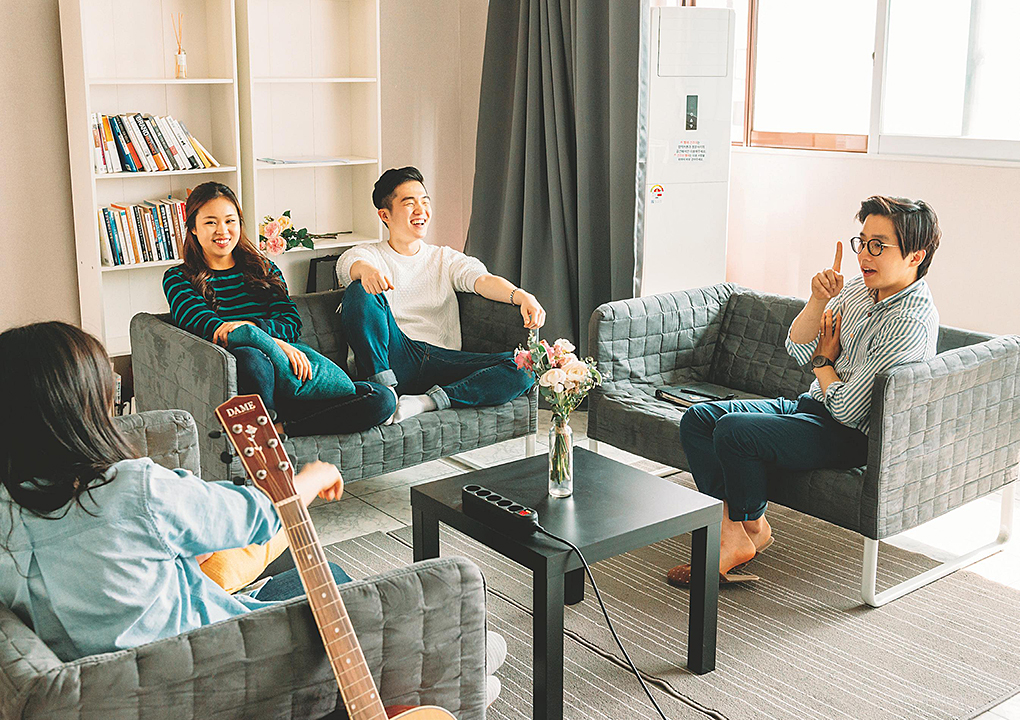
Residents of a shared house operated by the social enterprise Woozoo chat in the livingroom. To enhance a harmonious environment, the company pays attention to sharedinterests and common tastes when screening tenant applications. © Woozoo
Alternative Options
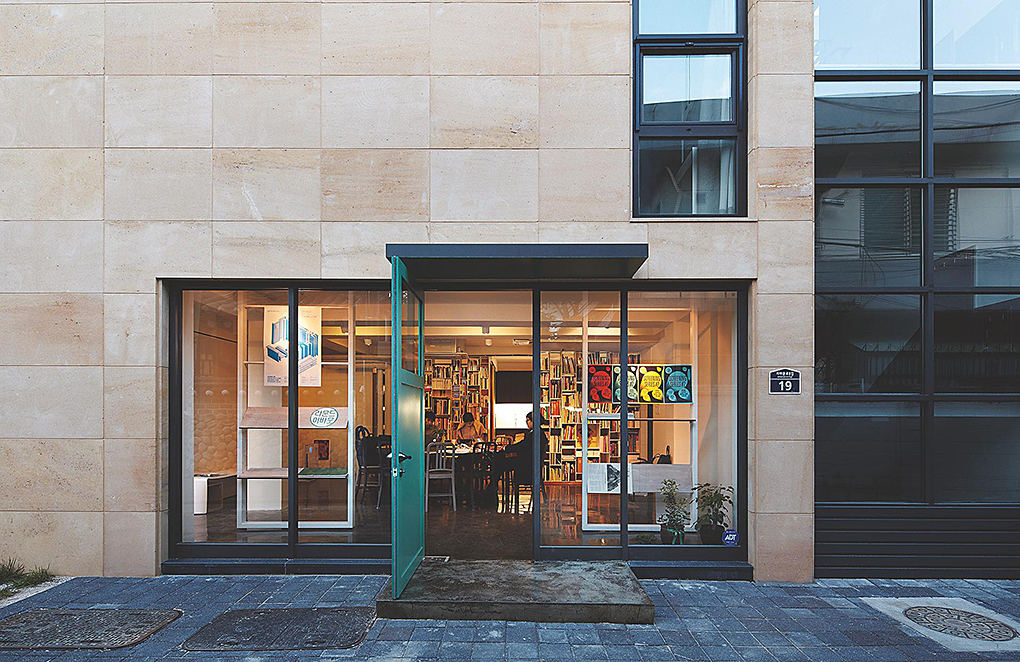
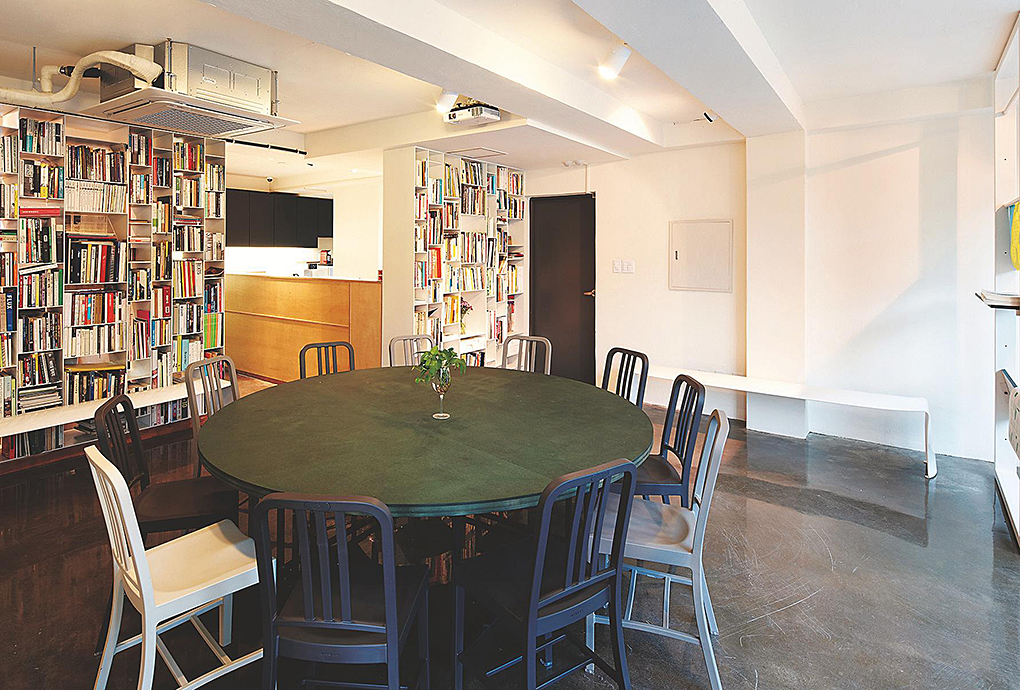
The first floor of the Junglim Foundation’s Tongui-dong Housein central Seoul is occupied by thefoundation’s office. Residents of theshared house can use it as a libraryand attend the foundation’s forumsand other events for free.© Kim Yong-kwan
The reality is that although people may have amassed more wealth, not many can say that they are happier. Loss of community has impeded the social connections that nurture emotional well-being and interaction. Countering this trend are new housing models that emerged in the 2010s, such as co-living, shared houses and housing cooperatives.
One- and two-person households underlie the rapid changes in Korea’s housing culture. Until the 1980s, the number of single households was statistically insignificant. By 2018, they constituted around 30 percent of all households. When added to the number of two-person households, they aggregate to well over 40 percent. This trend is certain to accelerate.
The number of vacant houses has also been steadily rising. In 2019, there were 1.4 million unoccupied and abandoned homes nationwide, with nearly 3,000 in Seoul alone. For a long time, purchasing a house was a lifelong goal for many Koreans. However, the breakdown of extended family living, the rise of single households and childless couples, and exorbitant property prices have dented the desire for home ownership. Residential units are regarded more and more as places to occupy rather than to own. Reflecting this changing perception, the number of single-person residential officetels (multi-purpose buildings) and studio apartments has soared. These housing options have, in turn, deepened social isolation.
But shared housing diminishes social isolation without sacrificing privacy. Though the concept is not yet widespread, it has made steady strides in recent years and is projected to expand further. Some notable examples include Junglim Foundation’s Tongui-dong House, Architects Office SAAI’s Uhjjuhdah House and dwellings managed by Woozoo.
Most shared houses are remodeled buildings. But Tongui-dong House in Jongno District, central Seoul, was designed and built specifically for shared living. Junglim Foundation and architectural firm Seoul Social Standard collaborated to give careful thought to efficient use of resources while minimizing discomforts that might arise from living with strangers.
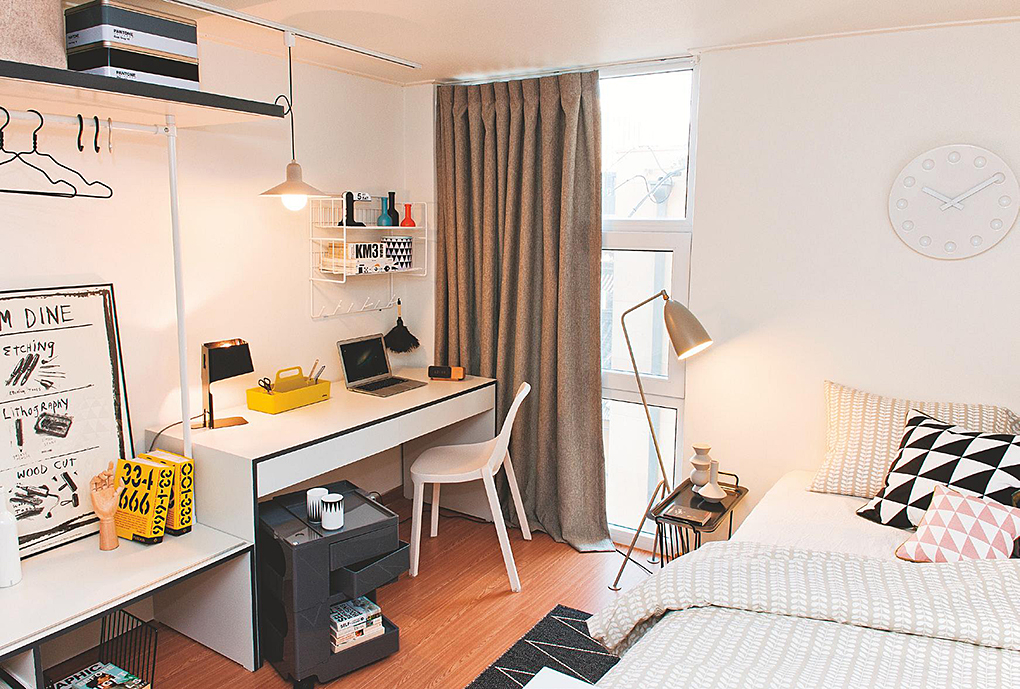
Tongui-dong House is a three-storybuilding with seven bedrooms on thesecond and third floors. To maximizespace for the shared kitchen, livingroom and bathrooms, the size ofindividual rooms was reduced, buteach room has a large window andefficient storage space. © Rooming
Shared housingdiminishes socialisolation withoutsacrificing privacy. Though the conceptis not yet widespread,it has made steadystrides in recent yearsand is projected toexpand further.
Distribution of Resources
The current housing style of choice among singles is an officetel, which typically includes a bedroom, kitchen and bathroom in a small space. Occupants have complete privacy and need not interact with their neighbors. But co-housing buildings encourage community interaction and relationships by making housing units less self-contained.
Tongui-dong House accommodates seven people. The private bedroom of each resident is relatively small in order to facilitate a large communal kitchen over 10 pyeong (around 33 square meters) in size where residents can socialize and share food. The bathrooms and laundry room are also communal areas, allowing for larger living spaces.
In his 2015 book “How to Thrive in the Next Economy: Designing Tomorrow’s World Today,” futurologist John Thackara cites Harvard University psychologists in writing that humans are more inclined to cooperate rather than compete for limited resources. He predicts that the sharing economy will become a fixture in our future lives and that use value (a commodity’s usefulness) will come to surpass exchange value (the same commodity’s market price). A communal living environment spares tenants from having to purchase household items such as kitchen appliances, for instance, because furnishings are shared, reducing waste.
Co-living buildings with residential units can naturally feel desolate when residents empty out during the workday. But mixed-use buildings housing both residents and commercial outlets such as a café or a store provide more frequent opportunities for residents to interact.
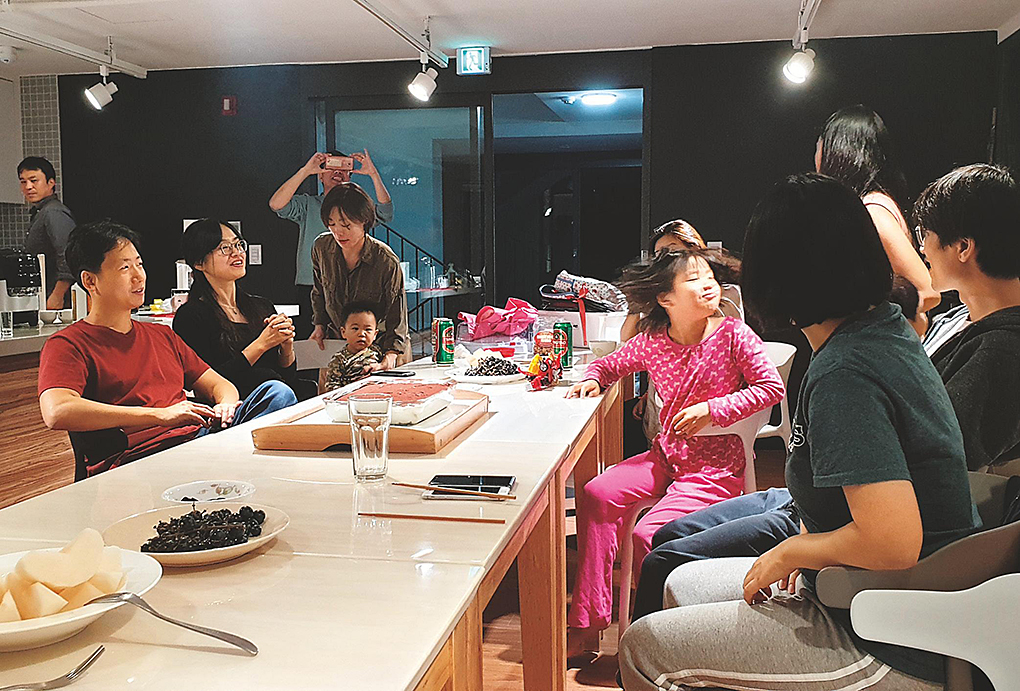
Residents of Yongdu-dong House mingleat a party held in their communal kitchenand dining room. Six households share theco-living residence in eastern Seoul. It has asmall theater, a bookstore-cum-café, a libraryand a study room for children, among othercommon spaces. © Junglim Foundation
Junglim Foundation occupies the first floor of Tongui-dong House and uses the space to conduct its forums and meetings. The foundation also receives deliveries for tenants when they are away, and since the lights are always on, tenants can feel like they are being greeted by family when they come home from work at night.
Can co-housing be considered a community? Perhaps not, but that is ultimately a moot point. What shared housing seeks to restore is not community per se but a “sense of community.” In pre-industrial Korea, there was far less mobility, so families, friends and acquaintances tended to stay in their home area. They involved themselves in others’ affairs, often to the point of being considered intrusive by today’s standards. Co-housing aspires to a sense of community that adopts the virtues of traditional living but rejects its negative aspects. This is a “loose community” where members don’t feel lonely or isolated and can help each other out when needed, while also maintaining a certain amount of distance. For example, people living in an apartment building would not be expected to take their sick neighbor to the hospital. But in a loose community, members would ideally spring into action in this sort of situation.
Alternative Options
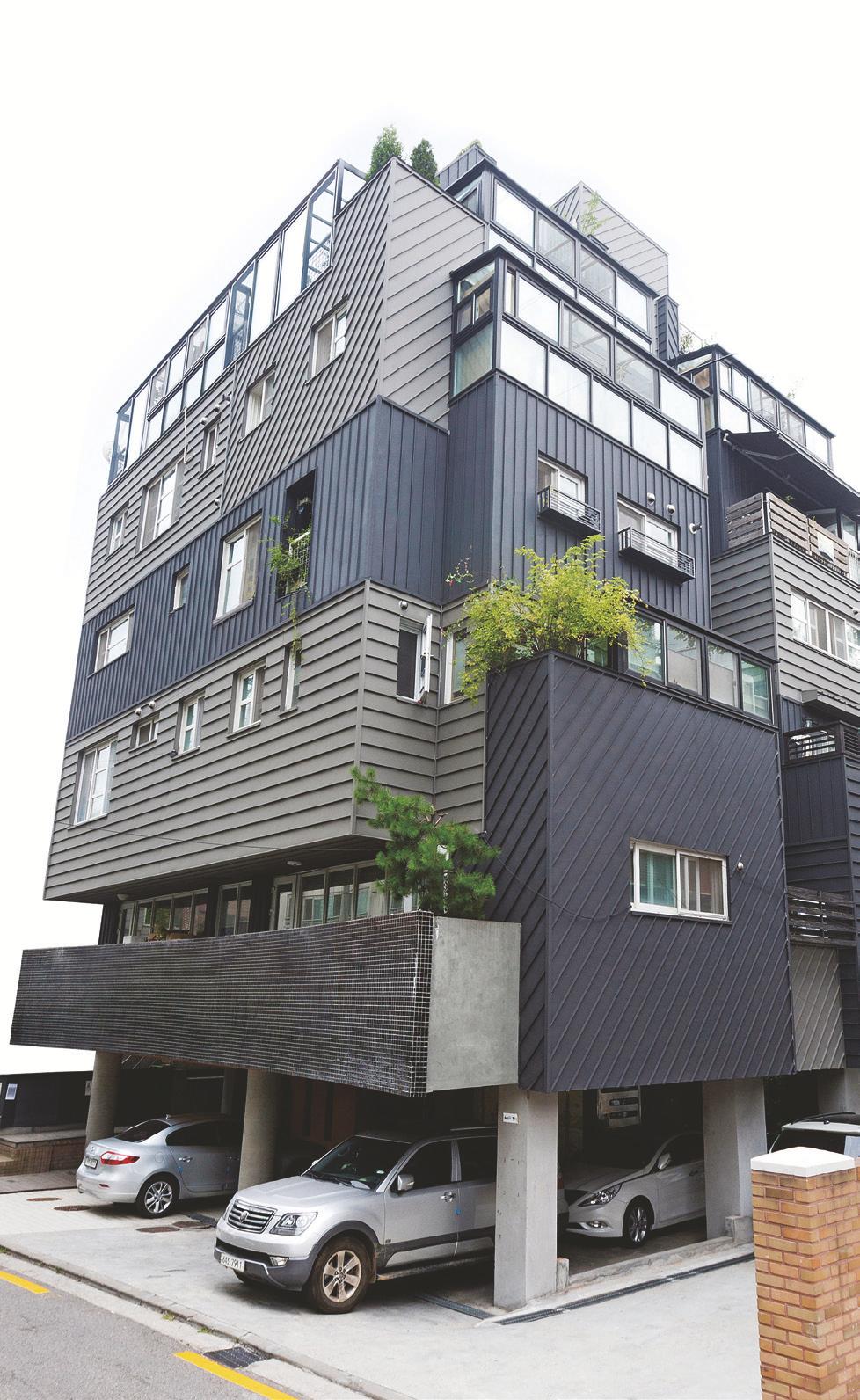
Sohaengju #1, the first cooperativehousing project in Mt. Seongmi village,Seongsan-dong, western Seoul, has acharacteristic appearance. The residentsparticipated in the design process, suffusinguniqueness into each living space. It wasbuilt in 2011. / Courtesy of “Monthly Design”
The reality is that although people may have amassed more wealth, not many can say that they are happier. Loss of community has impeded the social connections that nurture emotional well-being and interaction. Countering this trend are new housing models that emerged in the 2010s, such as co-living, shared houses and housing cooperatives.
One- and two-person households underlie the rapid changes in Korea’s housing culture. Until the 1980s, the number of single households was statistically insignificant. By 2018, they constituted around 30 percent of all households. When added to the number of two-person households, they aggregate to well over 40 percent. This trend is certain to accelerate.
The number of vacant houses has also been steadily rising. In 2019, there were 1.4 million unoccupied and abandoned homes nationwide, with nearly 3,000 in Seoul alone. For a long time, purchasing a house was a lifelong goal for many Koreans. However, the breakdown of extended family living, the rise of single households and childless couples, and exorbitant property prices have dented the desire for home ownership. Residential units are regarded more and more as places to occupy rather than to own. Reflecting this changing perception, the number of single-person residential officetels (multi-purpose buildings) and studio apartments has soared. These housing options have, in turn, deepened social isolation.
But shared housing diminishes social isolation without sacrificing privacy. Though the concept is not yet widespread, it has made steady strides in recent years and is projected to expand further. Some notable examples include Junglim Foundation’s Tongui-dong House, Architects Office SAAI’s Uhjjuhdah House and dwellings managed by Woozoo.
Most shared houses are remodeled buildings. But Tongui-dong House in Jongno District, central Seoul, was designed and built specifically for shared living. Junglim Foundation and architectural firm Seoul Social Standard collaborated to give careful thought to efficient use of resources while minimizing discomforts that might arise from living with strangers.
Neighborhood Hub
One other goal of Yongdu-dong House is to be a neighborhood hub. Among the residents is a Korean language teacher for foreign students; these students eat in the shared kitchen and study in the library. Likewise, if parents can’t pick up their children from daycare centers due to work, teachers will leave them in the common area where they can play with other children until their parents come home.
Small is Beautiful
How big is the house? Is it located in a good school district? How much canI expect the price to appreciate? These are the questions most Koreansmight ask when determining the value of a house. In recent years,however, more and more people want to construct a small but one-of-akind house where they can pursue a simpler life.
Very few Koreans live in a house containing their childhood memories. If their parents couldn’t afford to buy a house, the family would have had to move from one place to another every couple of years as leases expired. If their parents purchased a home and the value spiked upward, they would have sold it and moved to a bigger, nicer home, or a place in a better school district, hoping to improve the chances of their children getting into a top university.
Value Redefined
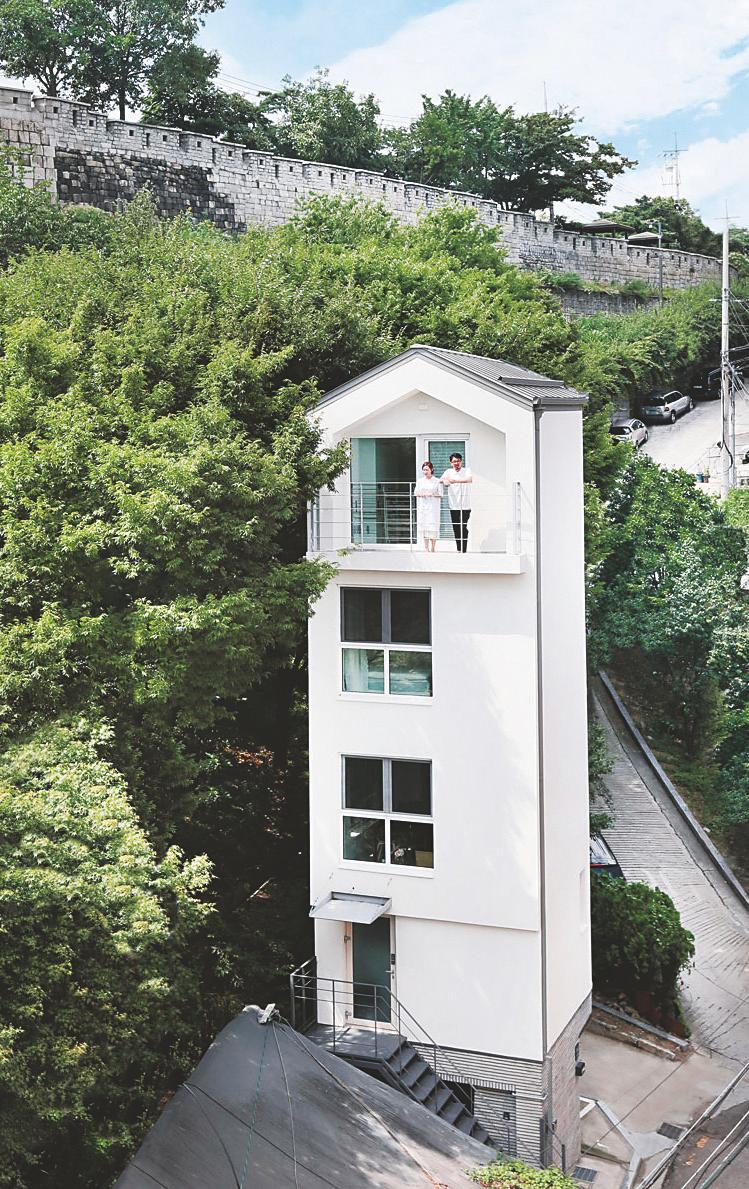
Seroro is a five-story residence built on a33.7m² plot adjacent to the Seoul City Wall inChangsin-dong, Seoul. As its name suggests,the house choreographs verticality, with eachfloor devoted to a different type of space:from the ground floor upward, garage,workroom, kitchen, bedroom, and dressingroom and bathroom. / Courtesy of “Monthly Green Friendly House”
The “peanut house” (duplex home) surfaced in the Korean media around 10 years ago, presenting an alluring alternative to standardized apartments. A peanut house is essentially two identical living units attached to each other and separated by a common wall. The name is inspired by the image of two peanuts in one shell. This is a cheaper option for those wanting to build a single-family house since the two households split the cost of the land and construction.
People were drawn to the concept of creating a living space with unique character at an affordable price. The peanut house gained popularity particularly among families weary of apartment life, young couples with differing values from the older generation and elderly couples whose children had moved out. They began building small houses with yards on modest plots of land they had purchased in the city or on inexpensive land in the suburbs.
Peanut house dwellers no longer judge the value of a house by its size, number of rooms or school district. They have come to appreciate finer details such as a window that frames the beautiful landscape outside, structural openings and interiors that change the effect of sunlight, the joy of a small yard and the privacy of an independent space.
These small houses can take on a variety of forms and designs depending on the topography of the sites on which they are built, the surrounding environment and the family structure of the inhabitants, as well as their preferences and expectations.
Building Upward
Most people who opt for a small house are not particularly rich. Purchasing land and building a house on a limited budget entails certain inconveniences. Since the house is constructed on a limited patch of land, the solution to creating more floor space is to build vertically. For couples, a two-story house may be sufficient, but families with children need to more space. An attic or split-floor plan to add more height to a room can be feasible options.
In the shift from the wide, horizontal layout of the traditional single-story house to a two-story peanut house, a staircase acts as a hallway. Children’s and parents’ rooms are usually on separate floors, guaranteeing more privacy.
In a large house, items are sure to pile up in proportion. Many of these things may be excessive, such as an outsized sofa, or hardly used, such as exercise equipment.
The desire to seek fulfillment through a bigger house and more material possessions has no place in a small house. Downsizing cannot be avoided; the moment you move into a small house, a lot of your stuff will need to be discarded. This makes you realize how beautiful a simple life free from material obsessions can be.
Park Seong-taeExecutive Director, Junglim Foundation